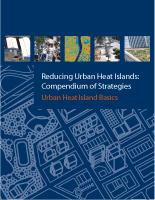
Urban areas are usually warmer than their rural surroundings, a phenomenon known as the “heat island effect.” As cities develop, more vegetation is lost and more surfaces are paved or covered with buildings. The change in ground cover results in less shade and moisture to keep urban areas cool. Built-up areas also evaporate less water, which contributes to elevated surface and air temperatures. Properties of urban materials, in particular solar reflectance, thermal emissivity, and heat capacity, also influence the development of urban heat islands, as they determine how the sun’s energy is reflected, emitted, and absorbed.
Heat islands can affect communities by increasing summertime peak energy demand, air conditioning costs, air pollution and greenhouse gas emissions, heat-related illness and mortality, and water quality.
Reducing Urban Heat Islands: Compendium of Strategies (October 2008) describes the causes and impacts of summertime urban heat islands and promotes strategies for lowering temperatures in U.S. communities. It provides an overview of heat islands, how they form, and their impacts, and describes key urban heat island reduction strategies in depth. It also describes voluntary and policy efforts undertaken by state and local governments to mitigate urban heat islands.
You will need Adobe Reader to view some of the files on this page. See EPA’s About PDF page to learn more.- Chapter 1: Urban Heat Island Basics (PDF)(22 pp, 2 MB)
- Chapter 2: Trees and Vegetation (PDF)(32 pp, 5 MB)
- Chapter 3: Green Roofs (PDF)(29 pp, 4 MB)
- Chapter 4: Cool Roofs (PDF)(31 pp, 3 MB)
- Chapter 5: Cool Pavements (PDF)(40 pp, 6 MB)
- Chapter 6: Heat Island Reduction Activities (PDF)(23 pp, 3 MB)
